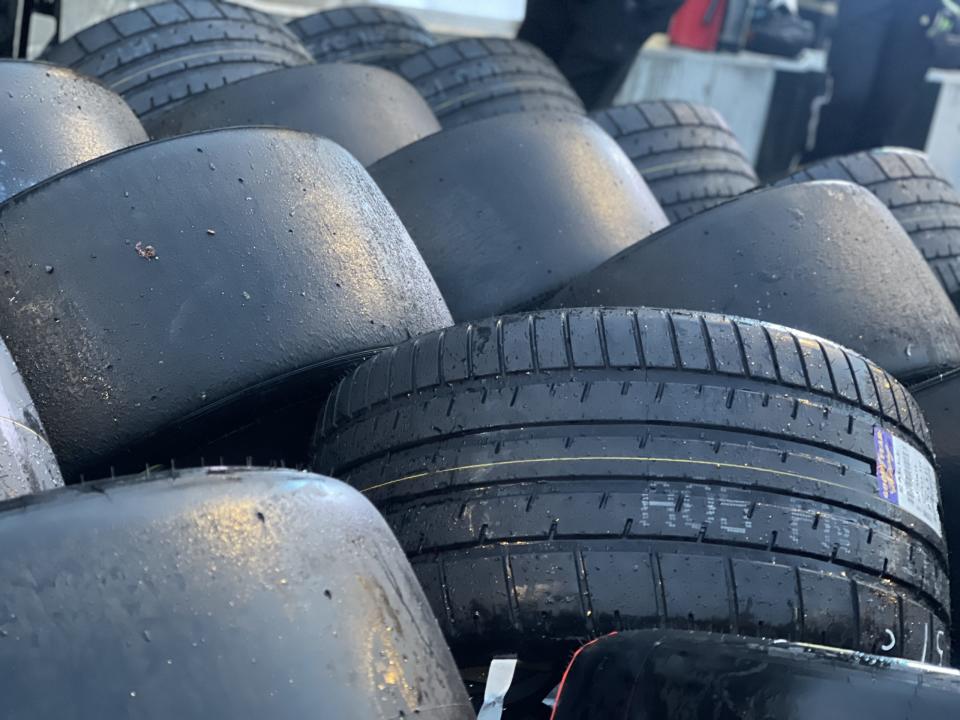Chicago sequel spotlights evolution of wet-weather racing in NASCAR
CHICAGO — Mother Nature decided to return for an encore performance for Sunday’s Chicago Street Race.
The NASCAR Cup Series returned to downtown Chicago for its second annual contest on the city streets and was met with rain literally moments after engines were fired to begin the Grant Park 165. With the 2.2-mile course declared wet, NASCAR officials allowed teams the option to choose whether they would begin the event on slick, untreaded Goodyear tires or the treaded wets.
RELATED: Race results
What resulted was an exhilarating race — if delayed partway by over 100 minutes thanks to heavier rain overtaking the course. Strategy mattered. Racers were challenged to show how they have evolved in wet conditions. Time became a factor as darkness encroached. And the challenge was in the hands of both the drivers and their crew chiefs.
“It was a crazy race from the start,” defending Cup champion Ryan Blaney said. “Split strategies getting going on dries and wets and then ended kind of on split strategies with dries and wets, so yeah, pretty crazy race. I mean, we put dries on and luckily ended up 10th. And I kind of gave a few spots away at the end. I kind of missed the corner and gave some up. But overall, just good finish from where it started today but pretty wild race.
“I’d like to run here one time where it’s, like, dry the whole time for the fans’ sake and our sake.”
Ultimately, the end result produced a marvelous chase from Tyler Reddick on slicks trying to catch Alex Bowman on wets. Wets won out with Bowman celebrating a victory, electing not to hit pit road and maximizing the tire life despite a drier line evolving to better suit slicks — even though crew chief Blake Harris was sure slick tires would be the optimal tires.
“We’d kind of made our opinion if we were in a good spot to pick up stage points today that we would take them,” Harris said. “And really, as the clock was winding down, you’re like, ‘Alright, well, if I plant us back in 20th or 25th here, we’re not going to have the rest of Stage 3 to make it up,’ which was kind of what we looked at at the beginning of race. So yeah, just asked him (Bowman).”

Bowman affirmed he wanted to stay on the wets, ultimately making the race-winning decision.
“That was our opportunity to win was staying out,” Harris said. “And we kind of discussed that, and once I had his confidence of knowing that that’s what we needed to do as well, it made my call pretty easy.”
Ease was difficult to find on Sunday’s cruise down Columbus Drive. Not every Cup driver has perfected wet-weather driving, which produced race-ending crashes for some. A Chase Briscoe slide into Turn 6 collected Shane van Gisbergen, who hit the wall and destroyed his right-front suspension, ending the defending race-winner’s day. Kyle Larson, who tried chasing him for victory in Saturday’s Xfinity race, slid nose-first into the Turn 6 tire barriers and crunched the front of his car.
But even despite the incident, Larson was pleased with NASCAR’s willingness to put decisions into the hands of the competitors.
“I thought that was nice that NASCAR let the teams have control of what to do with the strategy of the race,” Larson told NASCAR.com. “And you can see some guys missed the call, and they paid the price for it. So that’s what’s fun when you leave it in the team’s control. So that was neat and doing competitive pit stops, that was good, too. So yeah, I thought the overall event is still a success, and NASCAR’s learning more each time it rains.”
And while competition officials learn, so too the drivers. Wet-weather racing has become more common than ever before in recent NASCAR history, dating back to 2021 at Circuit of The Americas before the Next Gen vehicle was introduced in 2022.
“I think giving us the option to go with the wet tires and the dry tires at the beginning added an element of stress that I don’t think we’re necessarily used to,” Reddick, the runner-up, said. “So that was fun to decide what you wanted to do at the start of the race there. Fortunately, made the right choice. But yeah, I think back to Austin Cindric at COTA the first year we ran there, and he stayed out on dry tires a lot longer than everybody else and a lot further into damp conditions than anyone thought possible. And it was really fun learning just how to get the grip in the dry tire on a track that was getting more and more wet.”
More laps on wet surfaces provide drivers and teams with more data points from which to improve. But a street course like Chicago has its own unique quirks.
“It’s different here as opposed to like any oval or whatever,” Blaney said. “There’s so much more paint here just from the street. So much more paint. So that’s really kind of hard to navigate. It took them a while to kind of get the standing water off of the surface — like the concrete surface and just something with the city roads. It just doesn’t absorb water very well as opposed to, like, a race-track pavement. But yeah, got a lot of experience. It was slippery out there, and once we got the spray down after we went back going, I thought it was pretty good. And then it was, like, alright, how much grip does it have now as it continued to dry up. And it was hard to see because it was dark.
“But overall, yeah, pretty challenging day as a driver, but those days are fairly fun.”

 Yahoo Sports
Yahoo Sports 
